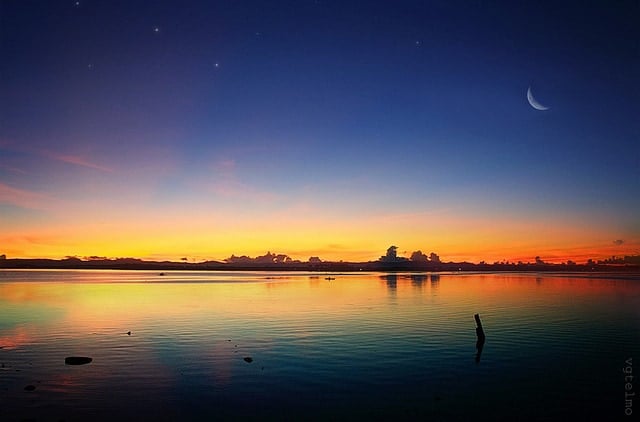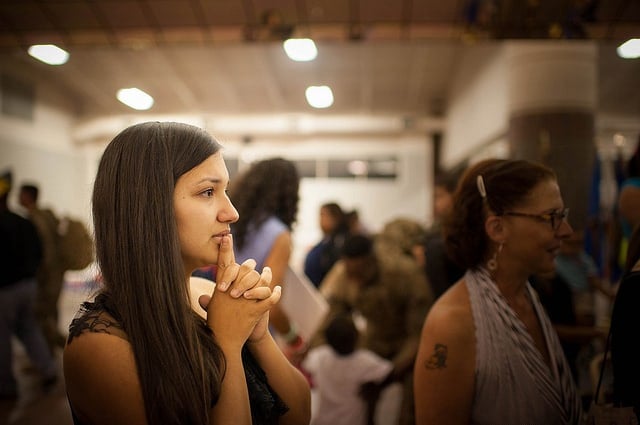I grew up in a purple parish, by which I do not mean that Our Lady of Lourdes Church in Massapequa Park, NY was a happy blend of Republican red and Democrat blue. It may have been, but I have something else on my mind. And like so much else at this time of year, that something else has to do with Christmas…but we will have to wait a bit to get there.
Come the start of Advent, which the church marks today, the priest at my parish wore purple vestments for about a month (save for that one Sunday on which he would wear a pink, rose, pink chasuble). For years, this was thoroughly unremarkable to me, but that changed when I started attending mass outside of my parish on occasion, say with a friend’s family at their church following a sleepover or during an overnight field trip with school. At first I thought something was awry with the lighting. That had to be it because, from where I was sitting, it looked like the priest was wearing…blue. The candles on the Advent wreath were…blue (except for that one pink, rose, pink candle). As sleepovers and field trips accumulated, and as I continued to pass eye exam after eye exam, I had to face a hard truth: there are purple parishes, and there are blue parishes.
For a while, I figured all of that might just have been the 1990s. Didn’t the economic boom of the Clinton years mean that parishes were awash in vestments of all manner of colors? Weren’t sacristies back then a whole lot like Jay Gatsby’s shirt-filled closets? Indeed, it has been years now since I have seen blue vestments or candles in a Catholic church during Advent, and there is no question that the liturgical marching orders are clear: violet is the proper liturgical color of Advent. Not long ago, however, a former professor of mine suggested in a class conversation that Advent blue came about in order to make a theological point. The true Advent color, he argued, was the color of the sky in the morning just before sunrise, a deep, rich blue. It is the last color the eye sees before the light returns.
I have never seen this explanation of the bygone blue vestments in any Catholic liturgical book, but I have placed what this professor told me in my mental basket of “if it isn’t true, it should be” facts. After all, playing on the dark-to-light transition is vintage Christmas. Houses and evergreen pine trees are about to get coated with sparkling lights and shiny ornaments; bright wrapping paper will soon be everywhere; fireplaces will be crackling wood (or some log-shaped assemblage of chemicals) before long.
On this front, the secular is taking its lead from the sacred. The first reading at Midnight Mass, the liturgy between the last Advent sunset and the first Christmas sunrise, comes from Isaiah: “The people who walked in darkness have seen a great light / Upon those who lived in a land of gloom a light has shone” (9:1). Then, perhaps most importantly, is the very date of Christmas. Its proximity to the winter solstice, the day when the minutes of sunlight each day stop decreasing and start increasing, is no coincidence. All of this gets summarized, I think, in the opening prayer, or collect, for Midnight Mass:
O God, who have made this most sacred night radiant
with the splendor of the true light, grant, we pray,
that we, who have known the mysteries of his light on earth,
may also delight in his gladness in heaven.
The mass continues, and, before long, the sun rises, the din of children opening up presents erupts, and, voilà. Christmas has begun again.
But let’s get back to the blue of the early morning sky, just before the first rays of the sun’s light appear. Regardless of how one feels about liturgical colors, that time, the time before first light, the dark, rich, blue time, is Advent time. Perhaps no word gets attached to that time as much as “waiting,” though “prepare” would have to be in the conversation as well.
I know that I would love it if “prepare” really were the key Advent word. Preparing gives me something to do. It means that I should probably have a checklist, which means that I should probably create an Excel spreadsheet, which means that I should probably shade the cells of that spreadsheet in such a way that I can really keep myself organized, which means that… All of this tells me that my variety of preparing is a far cry from waiting. Waiting is just hard. Even better…wait for it…the waiting is the hardest part. 1
For many people, myself included, quiet, patient waiting bears too close a resemblance to thumb-twiddling to be a worthwhile activity. Yet even if I did want to commit myself to making these weeks of Advent a time of real waiting, the rest of life will crash the party: final papers need to be written, travel plans to be with my family for Christmas must be made and executed, gifts for my niece and nephews will not appear out of nowhere. Trade out the specifics of my life and replace them with the specifics of yours. The result, I am guessing, will be the same: it takes a lot of energy to wait. Perhaps the deepest meaning of Advent, however, is that what can come from waiting is, well, worth the wait.
Rather than try to give a top 10 list of things that will try to interrupt our waiting – a list we all know too well – or to impart some advice about how we can try to sidestep all of that – advice that I know I myself am likely to ignore – let me bring us back once again to Advent blue. Believe it or not, I think it can help us see rather clearly one of the trickiest things that can interrupt our waiting.
The same set of liturgical marching orders hyperlinked above says that violet is also the liturgical color for Lent, a season that is decidedly penitential. All six weeks of Lent encourage taking a good, hard look at ourselves, in the hope of awakening the deeper knowledge that, even in the midst of our sinfulness, especially in the midst of our sinfulness, Christ showers us with mercy and forgiveness, calling us anew into intimate friendship. For me, this is the primary association I make with the priest’s violet vestments, be they at mass, or even more so, in the confessional. When I see them, and especially when I put them on myself, I start thinking about the gap that exists between who I say that I am, and who I really am. I also start thinking about how Christ really wants me to do nothing more than be myself. And when I start thinking like this, I am, in a manner of speaking, ensconced in Lenten violet.
And therein lies the beauty of Advent blue. It wants to cast out anything that gets in the way of our waiting for Christ to be born in Bethlehem two thousand years ago, in our hearts today, and, eventually, in the Second Coming on the last day. Yes, even if that “anything” is reflecting on our own sinfulness.
Now, don’t get me wrong: I am not advocating for the literal return of Advent blue. I think the violet looks just fine, thank you very much. And I am certainly not suggesting that going to confession or celebrating reconciliation with God through prayer, the Eucharist, or good works is a bad thing. Far from it! But I do think that the sort of mindset proper to Lent has no business being at the heart of Advent, even if the seasons’ liturgical colors are identical.
If Advent waiting leads one to the sacrament of reconciliation, then to the sacrament of reconciliation one should go. If it is to volunteer work, then volunteer. If it is to Macy’s, the Apple Store, or the Gap, then shop your heart out. But then come back. Then wait. This, I think, is the church’s Christmas gift to us…four weeks early.
- Go ahead and treat yourself: enjoy those periodic eight second close-ups of Tom Petty peppered throughout the video. ↩



